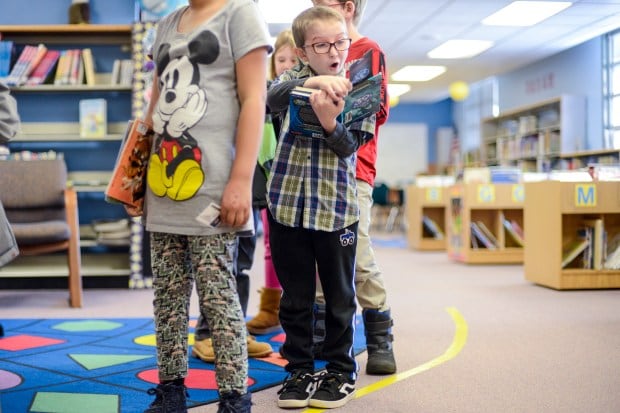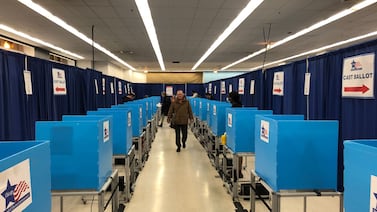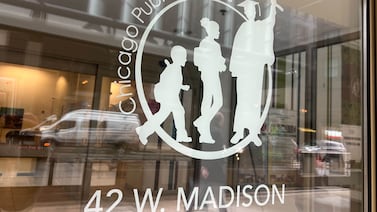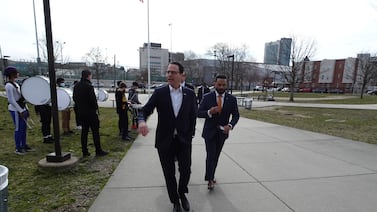Following the surprise closure of a small school in Jeffco this spring, families throughout the district are worried about the future of their own schools.
The common question is: How will Jeffco decide if it needs to close another school?
Jeffco has dozens of small schools, including 28 with fewer than 200 students, and the closure of Allendale Elementary with little public discussion or warning has rattled parents. While enrollment has shrunk steadily for several years, Jeffco has not created a long-term plan to address declining student numbers and the resulting shrinking budget.
“I don’t know what they’re looking at when it comes to making these decisions,” said Amanda Duran, the mother of a third grader at Swanson Elementary, one of the smaller schools in Jeffco and one that’s been on the chopping block before. “It’s scary to think about. Nobody wants their kids going from school to school to school.”
Enrollment in Jeffco schools, as in many other Colorado districts, has been declining for years. According to a Chalkbeat analysis, since 2016, the number of schools in Jeffco with 300 students or fewer shot up from 40 to 65 this year. That includes 28 schools with fewer than 200 students, up from 19 schools in that situation in the 2016-17 school year. The pandemic only accelerated the enrollment decline years in the making.
The district funds schools per student. So as enrollment shrinks, so does a school’s budget. While the school might hire fewer teachers, other costs — such a counselor or a principal — remain fixed, and when money gets tight the school has fewer resources and programs for students.
Still, some parents value small schools, where they believe their children get more attention and are known by all the adults. They hope the district sees that value, too.
Several other metro area districts are also dealing with declining enrollment. The 27J district in Brighton decided this year to repurpose one school after enrollment dipped below 200 students. Aurora decided this year to close two schools, and more closures may still come. Along with the closures, the district is creating magnet schools and specializations by region. Denver is planning to engage the community about how to deal with its declining enrollment.
Census data shows that although the population of Jeffco has increased in the past decade, the number of children has decreased. Once the largest district in the state, Jeffco has fallen to the second largest, behind Denver.
Parents worry that Jeffco failed to act before a crisis hit Allendale, the school Jeffco decided to close this year. District officials said they learned in February that because of families continuing to choose online learning, the school would have fewer than 100 students by next fall. Allendale had dipped below 200 students in 2018. Yet the district didn’t plan to help the school or prepare parents for possible closure sooner.
The district informed parents and staff it was considering closing the school at the end of March, and finalized the decision in mid-April, about a month before the end of the school year. Families scrambled to find other schools for the fall.
“They’ve known it’s a declining enrollment school for years,” said Jess Whetzel, a mother of two Jeffco children, including one at Allendale. “I have lost trust that the district will create a plan that will help those low enrollment schools or that even addresses it.”
Whetzel said that if the district knew more than half of the children in the attendance boundary for Allendale were choosing to go to other schools, it should have surveyed families to find out why.
“People aren’t necessarily just wanting traditional schools anymore,” Whetzel said. “That’s why charter schools fill up.”
One board member, Stephanie Schooley, said the board is planning to discuss long-term issues, including what to do with small schools, at a meeting in August. District officials said in an email that they agree with the need to study enrollment declines and want to have a better process and clearer criteria for closure decisions. They did not grant an interview request.
Schooley’s own children attended Stober Elementary, a school that was considered for closure in the past, and she represents an area of Jeffco close to Denver that has seen the most drastic enrollment declines.
Those drastic declines are happening in areas like Arvada where new development is contributing to rising housing prices that have pushed some families out. But other common factors like an aging population and declining birth rates also contribute to the enrollment trends.
Schooley said she’s fielded many questions and concerns about potential school closures.
“It’s an issue that has to be addressed,” Schooley said. “It’s not going to go away.”
Jeffco has faced these questions before. In 2017, the then-superintendent proposed closing five elementary schools. After considerable pushback, the board voted on a new plan to close only one school and spared the others while a better plan to identify schools to close could be hatched.
Shortly after, a new superintendent, Jason Glass, issued a moratorium on school closures to allow time for drafting and reviewing policies and procedures. But no new process or policies materialized.
The district has morphed a handful of schools into new programs in hopes of attracting new students, without much success.
Pennington, an elementary school spared closure in 2017, was converted to an expeditionary learning program. Data shows that the school’s enrollment decline slowed but did not stop. The school serves about 188 students this year.
At another school, Foster elementary, the community pushed the district to create a K-8 dual language program. That rollout was just completed, but the school’s enrollment has continued to decline.
Thomas Toch, the director of FutureEd, a think tank at Georgetown University, said that districts like Jeffco, that have a common enrollment system that allows families to easily choose a school outside their neighborhood, should track trends of what parents are looking for in schools.
“They should be planning how to respond to parental preferences in a way that ensures, among other things, that there are programs that parents want within a reasonable distance of where they live,” Toch said.
“There’s not really any excuse,” for closing a school with such short notice, Toch said. “They’ve seen enrollment declines for several years. It’s easy to spot these trends when you’ve got a common enrollment system.”
At the end of the day, schools with fewer than 200 students are inefficient. A district can revise program offerings according to parent demand, but also must consider a declining population, he said.
School board member Schooley believes the district’s plan for small schools must include listening to and engaging with the community, something many argue didn’t happen in the quick closure of Allendale this year. Also, school officials must review policies that might be disproportionately burdening lower-income neighborhoods that are losing more students.
She believes Jeffco should reconsider student-based budgeting, she said.
As far as whether the situation at Allendale might be repeated, Schooley tells parents she doesn’t expect it to. At Allendale, the district said the principal’s departure and the sudden realization that fewer than 100 students would be in the building next fall contributed to the quick decision. The district was also under management by an interim superintendent, during a pandemic.
“There is in no way an interest in having emergency closures of schools ever again,” Schooley said. “I know it’s disruptive and fraught with a whole lot of emotion that’s real. I don’t have any joy in being part of that.”
Parent Debbie Hansen moved her three children from Peck Elementary in Arvada, one of the other Jeffco small schools spared from closure in 2017, to Mountain Phoenix, a Jeffco charter school using the alternative Waldorf model of learning that tends to be more hands-on and focuses on children’s developmental stages.
Hansen still cares about Peck, and hopes the district won’t look at closing it again, but said families have left for many reasons. In her case, she was uncomfortable with the school’s new principal, who came from a high school, and she wanted a different model of learning for her children.
“I felt like they needed a different teaching style and smaller classroom sizes,” Hansen said.
Mountain Phoenix is among Jeffco schools whose enrollment has grown over the past five years. About a third of those growing schools are charters.
Hansen said that after a year of remote learning, school districts might find parents are more willing to approve tax increases.
“I understand the money concerns, I 100% do, but at some point we got to stop thinking about the money part of it and think about the kids,” Hansen said. “Test scores would be better for all the students if they had smaller classroom sizes. And parents might decide whatever the schools need for taxes, they’ll get.”
Many of the parents of small schools say the district should value them more.
Duran, the mother of a student at Swanson, thinks its small school environment may have helped her son. After struggling with reading, he now has higher scores and is reading at grade level.
That came after a lot of one-on-one support.
“It’s a good thing to have those numbers up, but then would my son suffer if he doesn’t have that one-on-one throughout the year?” Duran asked.
Her son also has epilepsy, and Duran has peace of mind knowing that all of the teachers know him and his situation, and could respond if he ever had a seizure at school.
“It’s kind of made me feel good,” Duran said.







